Alienware Area-51 m9750: Power Gaming on the Go
by Jarred Walton on August 24, 2007 8:00 AM EST- Posted in
- Laptops
Battery Life
As mentioned earlier, we had some difficulty getting a clean install of Windows XP onto the m9750, so we had to skip the BAPCo benchmarks, including MobileMark 2005. Obviously, we don't expect a lot in terms of battery life for this particular notebook, but we were curious to see exactly how fast we could run the battery dead. We turned to the battery scripts that we developed for Windows Vista along with our gaming battery benchmark where we loop 3DMark06. Let's see how the Area-51 manages to run without its tether.

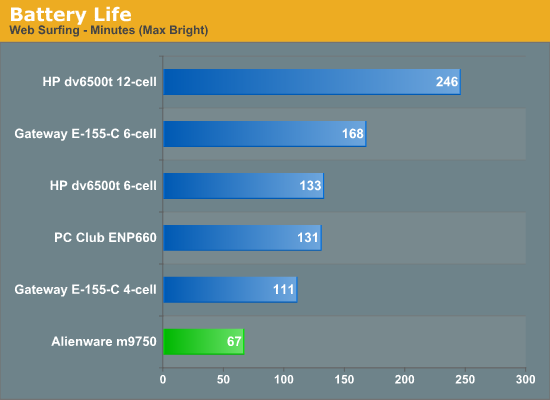
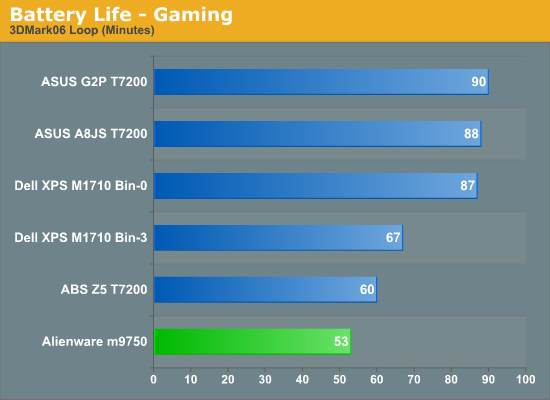
Despite having a rather large 12-cell battery, best case the m9750 provides just over an hour of battery life. That's with all of the power saving features turned on. Gaming performance can't even make it up to one hour, but it's also important to mention that NVIDIA's PowerMizer settings are in effect, reducing the GPU clock speeds and most likely disabling (or at least tampering) SLI performance. We did try to run 3DMark06 with PowerMizer disabled, but the laptop would shut down after a few minutes and it appears that clock speeds were still reduced. Not surprisingly, the only conclusion is that battery life certainly isn't a priority with the m9750.
Power Consumption
Related to the battery life discussions, we also have power results. To measure power requirements, we remove the battery from the laptop and measure system power draw at the wall outlet using a Kill-A-Watt device. We test several different scenarios to try to isolate the power draw of the various components. First, we have the baseline measurement when the system is idle and sitting at the desktop. No applications are running for 10 minutes or more but the screensaver and hard drive sleep mode are disabled. As a CPU load test, we run the SMP version of Folding@Home at 100%. Finally, for maximum power load we leave Folding@Home running and start 3DMark05. In this way, we can see roughly how much power the GPU is using in 3D mode versus 2D mode.
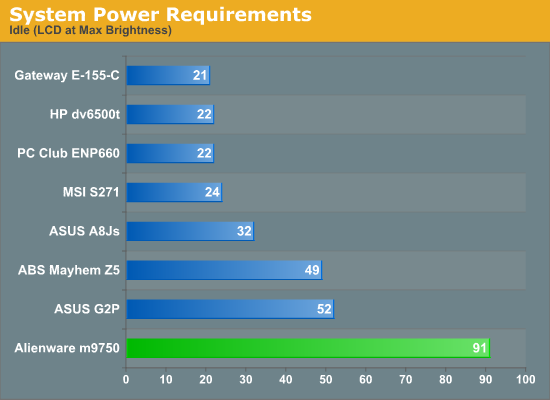
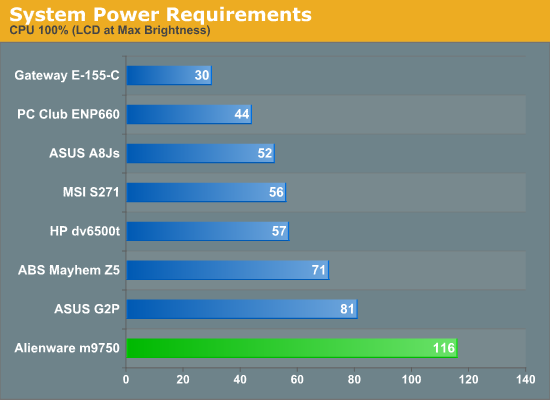
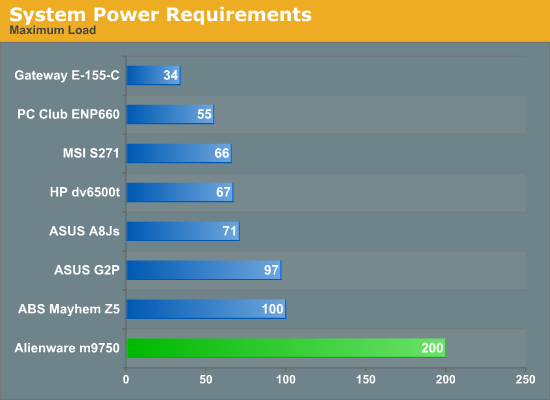
The power requirements are off the hizzy indeed! At maximum load, the m9750 consumes twice as much power as the nearest competitor. The 100% CPU test load however shows that the graphics cards are a major factor, as the m9750 "only" requires 45-75% more power under those situations. The good news is that even with such high power requirements, the large power brick is able to provide enough power that you can start gaming with a dead battery and still charge the battery. Then again, do you really need a battery for this type of notebook?
Temperatures
Given the amount of power that the m9750 can use, it's no surprise that the bottom can get pretty hot. While we tend to use the terms "laptop" and "notebook" interchangeably, the m9750 is definitely more at home sitting on the desk rather than in your lap - though it might come in handy during the winter months.

Here's another shot of the bottom of the notebook with temperatures superimposed (the rear of the notebook is at top and the front is at the bottom). Temperatures were measured after playing a game for 30 minutes. At idle, the laptop is cooler, but much of the bottom still gets above 35°C.
At the back of the notebook, the right exhaust port reaches 60°C at full load, and the left (center) exhaust reaches 55°C. Despite all that heat, however, the keyboard and palm rest remain generally cool. The palm rest stays a pretty consistent 31°C over the entire surface. The keyboard is a bit warmer, ranging from 33 to 36°C.
As mentioned earlier, we had some difficulty getting a clean install of Windows XP onto the m9750, so we had to skip the BAPCo benchmarks, including MobileMark 2005. Obviously, we don't expect a lot in terms of battery life for this particular notebook, but we were curious to see exactly how fast we could run the battery dead. We turned to the battery scripts that we developed for Windows Vista along with our gaming battery benchmark where we loop 3DMark06. Let's see how the Area-51 manages to run without its tether.



Despite having a rather large 12-cell battery, best case the m9750 provides just over an hour of battery life. That's with all of the power saving features turned on. Gaming performance can't even make it up to one hour, but it's also important to mention that NVIDIA's PowerMizer settings are in effect, reducing the GPU clock speeds and most likely disabling (or at least tampering) SLI performance. We did try to run 3DMark06 with PowerMizer disabled, but the laptop would shut down after a few minutes and it appears that clock speeds were still reduced. Not surprisingly, the only conclusion is that battery life certainly isn't a priority with the m9750.
Power Consumption
Related to the battery life discussions, we also have power results. To measure power requirements, we remove the battery from the laptop and measure system power draw at the wall outlet using a Kill-A-Watt device. We test several different scenarios to try to isolate the power draw of the various components. First, we have the baseline measurement when the system is idle and sitting at the desktop. No applications are running for 10 minutes or more but the screensaver and hard drive sleep mode are disabled. As a CPU load test, we run the SMP version of Folding@Home at 100%. Finally, for maximum power load we leave Folding@Home running and start 3DMark05. In this way, we can see roughly how much power the GPU is using in 3D mode versus 2D mode.



The power requirements are off the hizzy indeed! At maximum load, the m9750 consumes twice as much power as the nearest competitor. The 100% CPU test load however shows that the graphics cards are a major factor, as the m9750 "only" requires 45-75% more power under those situations. The good news is that even with such high power requirements, the large power brick is able to provide enough power that you can start gaming with a dead battery and still charge the battery. Then again, do you really need a battery for this type of notebook?
Temperatures
Given the amount of power that the m9750 can use, it's no surprise that the bottom can get pretty hot. While we tend to use the terms "laptop" and "notebook" interchangeably, the m9750 is definitely more at home sitting on the desk rather than in your lap - though it might come in handy during the winter months.

Here's another shot of the bottom of the notebook with temperatures superimposed (the rear of the notebook is at top and the front is at the bottom). Temperatures were measured after playing a game for 30 minutes. At idle, the laptop is cooler, but much of the bottom still gets above 35°C.
At the back of the notebook, the right exhaust port reaches 60°C at full load, and the left (center) exhaust reaches 55°C. Despite all that heat, however, the keyboard and palm rest remain generally cool. The palm rest stays a pretty consistent 31°C over the entire surface. The keyboard is a bit warmer, ranging from 33 to 36°C.










26 Comments
View All Comments
Frumious1 - Friday, August 24, 2007 - link
Oop - was apparently posting at the same time as you. Count me for keeping the graphs as is!Marlin1975 - Friday, August 24, 2007 - link
It still uses the 945 chipset and not the newwer 965?I would think being on the cutting edge it would benifit fromt he new Mem. controller and other upgrades the 965 had?
toon26 - Saturday, September 8, 2007 - link
I have buy this portable with 4 giga of mémory but the bios reconize just 2559Mb of méméory.Commercial service of alienware For the small history my son comes to acquire this portable with option 4 giga of memory (it makes studies to become data-processing engineer) and appear that the BIOS of this portable recognizes only 2555Mo of memory.
The engineering department of Alienware is informed of a problem on this BIOS. The sales department of Alienware wants to offer a mouse well to my son for the damage undergoes (the option to pass from 2 to 4 giga has to cost 280 to him€, for a portable with 3400€)
Most comic of the history it is that the site of Alienware always proposes this option of the 4 gigas who is completely unusable so much than a new BIOS will not come to correct this problem.
All the tests which I could read on this portable in the newspaper industry or on Internet were made only with 2 giga of memory, and thus nobody could locate this BUG, not even the Alienware company which is praised to make pass more than 200 tests to your portable before sending it to you
JarredWalton - Saturday, September 8, 2007 - link
Which is why I have the following in the review:The OS options further cement the deal: no 64-bit, don't bother with the hugely expensive memory upgrade! And of course, for 64-bit you'd need new GPU drivers, which are MIA.
yacoub - Monday, September 3, 2007 - link
Nope, most major laptop manufacturers (Dell/Alienware being prime examples) seem to have a fetish for extremely over-priced laptops with outdated chipsets. Here, pay $5,000 and we'll give you 945 and DX9. WOW WHAT A DEAL! ;PJarredWalton - Friday, August 24, 2007 - link
It's a case of time to market. SLI notebooks were initially demoed at CES 2006. The first ones didn't show up until quite a bit later, and they were Go 7900 GTX cards. NVIDIA released the faster Go 7950 GTX, but I don't believe laptops supporting the faster cards became available until early 2007. Alienware probably doesn't have to resources to update their laptop line every time a new chipset comes out. Besides, they'd still have to deal with NVIDIA's driver updates (or lack thereof), and Santa Rosa wouldn't make that big of a difference in most titles - especially not in the GPU limited games.